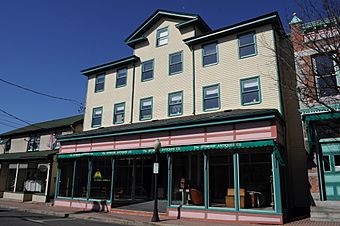Downtown Seymour Historic District facts for kids
Quick facts for kids |
|
|
Downtown Seymour Historic District
|
|
 |
|
| Location | Roughly bounded by the Naugatuck River, Main, Wakeley, and DeForest Sts., Seymour, Connecticut |
|---|---|
| Area | 21 acres (8.5 ha) |
| Built | 1850 |
| NRHP reference No. | 83001279 |
| Added to NRHP | August 25, 1983 |
The Downtown Seymour Historic District is a special area in Seymour, Connecticut. It's like a time capsule showing how the town grew in the mid-1800s. This district is famous for its old factories and buildings that made things from brass. It was added to the National Register of Historic Places in 1983, which means it's an important historical site worth protecting.
Contents
What is a Historic District?
A historic district is a group of buildings, structures, or sites that are important because of their history or architecture. These areas are protected to help people remember and learn about the past. The Downtown Seymour Historic District helps us understand how towns in Connecticut grew around factories and rivers.
A Look Back: Seymour's Early Days
The area we now call Seymour was once part of Derby. It became its own town in 1850. Its story of industry began in the late 1700s. Two men, John Wooster and Bradford Steele, started a blacksmith shop. Later, they built mills near the Naugatuck River to process cloth.
The Merino Sheep Story
In 1803, a general named David Humphreys bought land near these mills. He started what might be one of the oldest wool factories in the United States! General Humphreys brought a special type of sheep called merino sheep all the way from Spain. These sheep are known for their very fine wool, which was perfect for making high-quality cloth.
Industry Takes Off!
The town really started to grow when the railroad was built in the late 1840s. This made it much easier to move goods and materials. From the 1840s until the 1920s, Seymour's downtown area developed quickly. During this time, making things from copper and brass became one of the town's most important businesses.
Exploring the District Today
The Downtown Seymour Historic District covers about 21 acres (8.5 hectares). It sits in a curve of the Naugatuck River. Modern Route 8 runs along one side, and the old Naugatuck Railroad tracks (now the Waterbury Branch) are on the other.
Buildings and History
Most of the buildings in the district are commercial, meaning they were used for businesses. They were built mostly between 1880 and 1940. There are only a few homes, which are mostly wooden houses from the late 1800s.
One of the oldest buildings is thought to be the Trestle Tavern at 26-28 Main Street. It was built around 1850. At the southern end of the district, you can see the old Waterman Pen complex. This was an important industrial site connected to Seymour's brass industry. Many of its buildings are from the early 1900s. The town's main public buildings, like the town hall, post office, and fire station, are also located just north of this industrial area.



